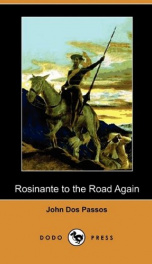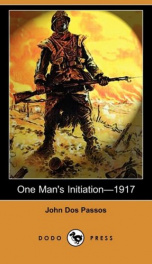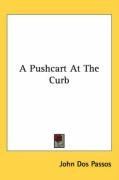Dos Passos John

John Roderigo Dos Passos (January 14, 1896 – September 28, 1970) was an American novelist and artist. Dos Passos was born in Chicago, Illinois, the illegitimate son of John Randolph Dos Passos Jr. (1844-1917). The elder Dos Passos was a lawyer of Madeiran Portuguese descent, the son of John Randolph Dos Passos and Mary Hays and the brother of Louis Hays Dos Passos. He was an authority on trusts and a staunch supporter of the powerful industrial conglomerates his son would come to oppose in his fictional works of the 1920s and 30s. In 1910, he married Lucy Addison Sprigg Madison, from Petersburg. Although he provided for his son's schooling, he refused to acknowledge him until two years after his marriage (when his son was 14). The younger Dos Passos received a first-class education, enrolling at The Choate School in Wallingford, Connecticut in 1907 under the name John Roderigo Madison, then traveling with a private tutor on a six-month tour of France, England, Italy, Greece, and the Middle East to study the masters of classic art, architecture, and literature. In 1912 he attended Harvard University. Following his graduation in 1916 he traveled to Spain to study art and architecture. With World War I raging in Europe and America not yet participating, Dos Passos volunteered in July 1917 for the S.S.U. 60 of the Norton-Harjes Ambulance Corps, along with friends E. E. Cummings and Robert Hillyer. He worked as a driver in Paris and in north-central Italy. By the late summer of 1918, he had completed a draft of his first novel. At the same time, he had to report for duty with the U.S. Army Medical Corps at Camp Crane in Pennsylvania. At war's end, he was stationed in Paris, where the U.S. Army Overseas Education Commission allowed him to study anthropology at the Sorbonne. A character in U.S.A. goes through virtually the same military career and stays in Paris after the war. Considered one of the Lost Generation writers, Dos Passos' first novel was published in 1920. Titled One Man's Initiation: 1917 it was followed by an antiwar story, Three Soldiers, which brought him considerable recognition. His 1925 novel about life in New York City, titled Manhattan Transfer, was a commercial success and introduced experimental stream-of-consciousness techniques into Dos Passos' method. At this point a social revolutionary, Dos Passos came to see the United States as two nations, one rich and one poor. He wrote admiringly about the Wobblies and the injustice in the criminal convictions of Sacco and Vanzetti and joined with other notable personalities in the United States and Europe in a failed campaign to overturn their death sentences. In 1928, Dos Passos spent several months in Russia studying their socialist system. He returned to Spain with Hemingway during the Spanish Civil War, but his views on the communist movement had already begun to change. Dos Passos broke with Hemingway and Herbert Matthews over their cavalier attitude towards the war and their willingness to lend their names to Stalinist propaganda efforts. (In later years, Hemingway would give Dos Passos the derogatory moniker of "the pilot fish" in his memoirs of 1920s Paris, A Moveable Feast.) These ideas coalesced into the USA trilogy (see below), of which the first book appeared in 1930. Dos Passos attended the 1932 Democratic National Convention and subsequently wrote an article for The New Republic in which he harshly criticized the selection of Franklin Delano Roosevelt as the party's nominee. In the mid-1930s he wrote a series of scathing articles about communist political theory, and created an idealistic Communist in The Big Money who is gradually worn down and destroyed by groupthink in the party. As a result of socialism gaining popularity in Europe as a response to Fascism, there was a sharp decline in international sales of his books. His politics, which had always underpinned his work, moved far to the right. (He came to admire Joseph McCarthy in the early 1950s.) Nevertheless, recognition for his significant contribution in the literary field would come thirty years later in Europe when, in 1967, he was invited to Rome to accept the prestigious Antonio Feltrinelli Prize for international distinction in literature. Although Dos Passos' partisans have contended that his later work was ignored because of his changing politics, there is a consensus among critics that the quality of his novels drastically declined following U.S.A. Between 1942 and 1945, Dos Passos worked as a journalist covering World War II. In 1947, he was elected to the American Academy of Arts and Letters, but tragedy struck when an automobile accident killed his wife of 18 years, Katharine Smith, and cost him the sight in one eye. The couple had no children. He eventually was remarried to Elizabeth Hamlyn Holdridge (1909-1998) in 1949, by whom he had an only daughter, Lucy Hamlin Dos Passos (b. 1950), and he continued to write until his death in Baltimore, Maryland in 1970. He is interred in Yeocomico Churchyard Cemetery in Cople Parish, Westmoreland County, Virginia, not far from where he had made his home. Over his long and successful career, Dos Passos wrote forty-two novels, as well as poems, essays, and plays, and created more than 400 pieces of art. His major work is the U.S.A. trilogy comprising The 42nd Parallel (1930), Nineteen Nineteen or 1919 (1932), and The Big Money (1936). Dos Passos used experimental techniques in these novels, incorporating newspaper clippings, autobiography, biography and fictional realism to paint a vast landscape of American culture during the first decades of the twentieth century. Though each novel stands on its own, the trilogy is designed to be read as a whole. Dos Passos' political and social reflections in the novel are deeply pessimistic about the political and economic direction of the United States, and few of the characters manage to hold onto their ideals through the First World War. Before becoming a leading novelist of his day, John Dos Passos sketched and painted. During the summer of 1922, he studied at Hamilton Easter Field's art colony in Ogunquit, Maine. Many of his books published during the ensuing ten years used jackets and illustrations that Dos Passos created. Influenced by various movements, he merged elements of Impressionism, Expressionism, and Cubism to create his own unique style. And his work evolved with his first exhibition at New York's National Arts Club in 1922 and the following year at Gertrude Whitney's Studio Club in New York City. While Dos Passos never gained recognition as a great artist, he continued to paint throughout his lifetime and his body of work was well respected. His art most often reflected his travels in Spain, Mexico, North Africa, plus the streets and cafés of the Montparnasse Quarter of Paris that he had frequented with good friends Fernand Léger, Ernest Hemingway, Blaise Cendrars, and others. Between 1925 and 1927, Dos Passos wrote plays as well as created posters and set designs for the New Playwrights Theatre in New York City. In his later years, his efforts turned to painting scenes around his residences in Maine and Virginia. In early 2001, an exhibition titled The Art of John Dos Passos opened at the Queens Borough Library in New York City after which it moved to several locations throughout the United States. Dos Passos' pioneering works of nonlinear fiction were a major influence in the field. In particular Alfred Döblin's Berlin Alexanderplatz and Jean-Paul Sartre's The Roads To Freedom trilogy show the influence of his methods. In an often cited 1936 essay, Sartre referred to Dos Passos as "the greatest writer of our time". Perhaps the best-known work partaking of the collage technique found in U.S.A. is science fiction writer John Brunner's Hugo Award-winning 1968 "non-novel" Stand on Zanzibar, in which Brunner makes use of fictitious newspaper clippings, television announcements, and other "samples" taken from the news and entertainment media of the year 2010. Joe Haldeman's novel Mindbridge also uses the collage technique, as does his short story, "To Howard Hughes: A Modest Proposal". The John Dos Passos Prize is a literary award given annually by the Department of English and Modern Languages at Longwood University. The prize seeks to recognize "American creative writers who have produced a substantial body of significant publication that displays characteristics of John Dos Passos's writing: an intense and original exploration of specifically American themes, an experimental approach to form, and an interest in a wide range of human experiences."
do you like this author?
What readers are saying
What do you think? Write your own comment on this book!
write a commentWhat readers are saying
What do you think? Write your own comment on this author!
write a commentBook list

Rosinante to the Road Again
Series:
Unknown
Year:
Unknown
Raiting:
4.5/5
John Roderigo Dos Passos (1896-1970) was an American novelist and artist. In 1912 he attended Harvard University. Following his graduation in 1916 he travelled to Spain to study art and architecture. With World War I raging in Europe and America not yet participating, Dos Passos volunteered in July 1917 for the S. S.U. 60 of the Norton-Harjes Ambulance Corps. He worked as a driver in Paris and in north-central Italy. By the late summer of 1918, he had completed a draft of his first novel. Considered one of the Lost Generation writers, Dos Passos' first novel, One Man's Initiation- 1917, was published in 1920. It was followed by an antiwar story, Three Soldiers (1921). His major work is the U. S.A. trilogy comprising The 42nd Parallel (1930), Nineteen Nineteen (1932), and The Big Money (1936). Between 1942 and 1945, Dos Passos worked as a journalist covering World War II. His other works include: A Pushcart at the Curb (1922), Streets of Night (1923) and Journeys Between Wars (1938).
Show more
add to favoritesadd In favorites
Book list

Rosinante to the Road Again
Series:
Unknown
Year:
Unknown
Raiting:
4.5/5
John Roderigo Dos Passos (1896-1970) was an American novelist and artist. In 1912 he attended Harvard University. Following his graduation in 1916 he travelled to Spain to study art and architecture. With World War I raging in Europe and America not yet participating, Dos Passos volunteered in July 1917 for the S. S.U. 60 of the Norton-Harjes Ambulance Corps. He worked as a driver in Paris and in north-central Italy. By the late summer of 1918, he had completed a draft of his first novel. Considered one of the Lost Generation writers, Dos Passos' first novel, One Man's Initiation- 1917, was published in 1920. It was followed by an antiwar story, Three Soldiers (1921). His major work is the U. S.A. trilogy comprising The 42nd Parallel (1930), Nineteen Nineteen (1932), and The Big Money (1936). Between 1942 and 1945, Dos Passos worked as a journalist covering World War II. His other works include: A Pushcart at the Curb (1922), Streets of Night (1923) and Journeys Between Wars (1938).
Show more
add to favoritesadd In favorites

One Man's Initiation—1917
Series:
Unknown
Year:
Unknown
Raiting:
4.5/5
John Roderigo Dos Passos (1896-1970) was an American novelist and artist. In 1912 he attended Harvard University. Following his graduation in 1916 he travelled to Spain to study art and architecture. With World War I raging in Europe and America not yet participating, Dos Passos volunteered in July 1917 for the S. S.U. 60 of the Norton-Harjes Ambulance Corps. He worked as a driver in Paris and in north-central Italy. By the late summer of 1918, he had completed a draft of his first novel. Considered one of the Lost Generation writers, Dos Passosâ first novel, One Manâs Initiation- 1917, was published in 1920. It was followed by an antiwar story, Three Soldiers (1921). His major work is the U. S.A. trilogy comprising The 42nd Parallel (1930), Nineteen Nineteen (1932), and The Big Money (1936). Between 1942 and 1945, Dos Passos worked as a journalist covering World War II. His other works include: A Pushcart at the Curb (1922), Streets of Night (1923) and Journeys Between Wars (1938).
Show more
add to favoritesadd In favorites
What readers are saying
What do you think? Write your own comment on this author!
write a commentif you like Dos Passos John try:
readers also enjoyed
What readers are saying
What do you think? Write your own comment on this author!
write a commentGenre
if you like Dos Passos John try:
readers also enjoyed
Do you want to read a book that interests you? It’s EASY!
Create an account and send a request for reading to other users on the Webpage of the book!



